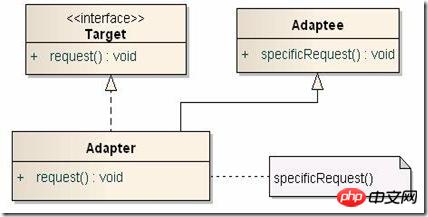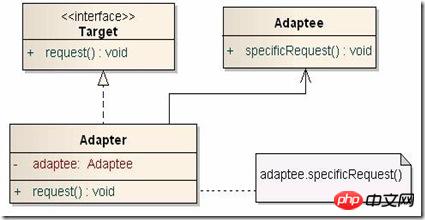Introduction to php adapter pattern
Jul 05, 2017 am 10:19 AMAdapter (alias Wrapper) mode: Convert the interface of one class into the interface of another class expected by the customer. Adapters allow classes with incompatible interfaces to work seamlessly together
Key points:
1. Adapter pattern is mainly used in situations where "you want to reuse some existing classes, but the interface is inconsistent with the requirements of the reuse environment", in the aspects of legacy code reuse, class librarymigration, etc. very useful.
2. The adapter pattern has two implementation structures: object adapter and class adapter. However, the class adapter adopts the "multiple inheritance" implementation method, which brings undesirable high coupling, so it is generally not used. Recommended Use. The object adapter adopts the "object combination" method, which is more in line with the spirit of loose coupling.
Implementation:

public interface Target { void request();}public class Adaptee{ public void specificRequest(){}}public class Adapter implements Target{ public Adapter(Adaptee adaptee) { super(); this.adaptee = adaptee; } public void request() { adaptee.specificRequest(); } private Adaptee adaptee;}behaviors of Adaptee, because Adapter is a subclass of Adaptee.
For object adapters: 1. Allow an Adapter to work with multiple Adaptee, that is, the Adaptee itself and all its subclasses (if there are subclasses) at the same time. Adapter can also add functions to all Adaptees at once. 2. Makes it difficult to override (redefine) the behavior of Adaptee. If you must override the Adaptee method, you have to first make a subclass of Adaptee to override the Adaptee method, and then use this subclass as the real Adaptee source for adaptation.The above is the detailed content of Introduction to php adapter pattern. For more information, please follow other related articles on the PHP Chinese website!

Hot Article

Hot tools Tags

Hot Article

Hot Article Tags

Notepad++7.3.1
Easy-to-use and free code editor

SublimeText3 Chinese version
Chinese version, very easy to use

Zend Studio 13.0.1
Powerful PHP integrated development environment

Dreamweaver CS6
Visual web development tools

SublimeText3 Mac version
God-level code editing software (SublimeText3)

Hot Topics
 PHP 8.4 Installation and Upgrade guide for Ubuntu and Debian
Dec 24, 2024 pm 04:42 PM
PHP 8.4 Installation and Upgrade guide for Ubuntu and Debian
Dec 24, 2024 pm 04:42 PM
PHP 8.4 Installation and Upgrade guide for Ubuntu and Debian
 How To Set Up Visual Studio Code (VS Code) for PHP Development
Dec 20, 2024 am 11:31 AM
How To Set Up Visual Studio Code (VS Code) for PHP Development
Dec 20, 2024 am 11:31 AM
How To Set Up Visual Studio Code (VS Code) for PHP Development













